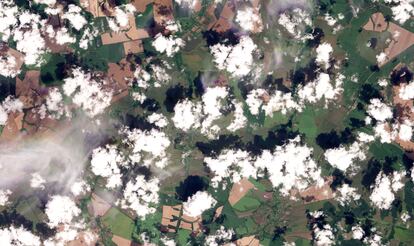Russia faces biggest incursion into its territory since the start of the invasion of Ukraine
Zelenskiy argues that the Kremlin must ‘feel what it has done,’ suggesting that the Ukrainian Army is behind the offensive in Kursk Oblast. Analysts believe the move is an attempt to draw away Russian forces from the Donetsk front


On Tuesday, Russia accused Ukraine’s Armed Forces of entering the Russian province of Kursk with a thousand soldiers and armored vehicles. President Vladimir Putin described the move as “a large-scale provocation,” and convened his security council to address the problem. In three days, Ukraine has occupied 11 villages or settlements and 17 square miles of land, taken at least 40 prisoners of war, leaving five dead and 31 wounded, according to data from the Russian Defense Ministry. In response, Russia declared a state of emergency in the region and, according to the Kremlin, ordered the evacuation of “several thousand people.”
Three days after the opening of this breach in the Ukrainian-Russian border, Ukrainian President Volodymyr Zelenskiy posted a message that suggested that Ukraine was responsible for the operation: “Russia brought the war to our land, and it should feel what it has done. We strive to achieve our goals as soon as possible in peacetime – under just peace conditions. And it will happen.”
Mykhailo Podolyak, the advisor to the head of the Office of the President of Ukraine, shared a similar message on X. “The root cause of any escalation, shelling, military actions, forced evacuations, and destruction of normal life forms, including within Rf’s own territories like Kursk and Belgorod regions, is solely Russia’s unequivocal aggression,” he wrote.
In a later television appearance, Podolyak added: “It is the army’s business to say what is going on there. As of today, we have a war that is gradually advancing into the interior of the Russian Federation. Will it scare them? Yes. Will they react with anything other than fear? No.”
The military operation initially raised questions about whether it was really the Ukrainian army — and not the paramilitary groups of Kremlin opponents, who have carried out such actions in border areas during the war — that was staging the largest incursion into Russian territory since the invasion of Ukraine began in February 2022. There were also doubts about the intended goal of the operation, and why it had been launched now.
Analysts and military experts who spoke to EL PAÍS trust in the information provided by the Institute for the Study of War (ISW), a reputable U.S. think tank, which on Thursday confirmed the Ukrainian movements in its daily report, based on geolocated images and internal Russian sources.
Renowned military analyst Mikhail Samus argues that Ukraine’s goal is to pressure Russian commanders so that they have to decide where to send their military assets, since many of them are in the Donbas region, partially controlled since 2014 by Moscow through pro-Russian separatists. “Putin has been trying to occupy Donetsk and Lugansk for 10 years; he wants to finish it before the U.S. elections in November, and he is going to invest all possible resources to achieve it,” says Samus.
Indeed, this summer Russian troops have stepped on its efforts in Donetsk province, with important strategic victories in several directions thanks to the mass shipment of infantry, ammunition and weapons. These movements are taking place amid certain urgency, since former U.S. president Donald Trump has warned that if he wins the November 4 election, he intends to end the war in Ukraine. And Putin wants to have control of Donetsk coming in to possible negotiations.
With the operation in Kursk, Ukraine has put the Russian army in a dilemma, says Samus. “They can stop the offensive in Donbas to defend Kursk or they can allocate fewer resources and risk losing some territory.”
Zelenskiy is also under pressure, as resisting Russia — and the money and weapons needed to do so — depends greatly on who wins the U.S. election, since Trump is against the U.S. continuing to finance the war.
It is therefore in Kyiv’s interest to gain ground in the face of future peace negotiations. According to Oleksiy Melnyk from the Razumkov Centre in Kyiv: “If Ukraine occupies a part of Russian territory, it can propose an exchange. It is very ambitious, but it is a clear political objective.”
Melnyk highlight the great strategic value of Kursk Oblast: the region has a functioning nuclear power plant, and is home to the town of Sudzha, the last operational distribution station for Russian natural gas headed for Europe via Ukraine. The Urengoy-Pomary-Uzhhorod pipeline will carry about 14.65 billion cubic meters of gas in 2023, roughly half of Russia’s gas exports to Europe, according to Reuters.
For now, Ukraine’s gas transmission operator has reported that fuel is moving normally to European consumers, but there is concern in the European market, with prices rising 4.5% on Wednesday, the highest level since December, according to Bloomberg. As for the nuclear power plant — located just 37 miles from where the offensive is taking place — the Russian National Guard reported that security around the facility has been reinforced.
Actions like the offensive Kursk are known in military jargon as asymmetric engagement, where a smaller force carries out effective operations against a larger enemy. Samus predicts that Ukraine will launch another: “Ukrainian forces may start new operations in the direction of Crimea with the new air weapons they have obtained, because there Ukraine has information from NATO, as well as aviation, and can destroy Russian bases,” he says.
Ukraine recently received the first F-16 fighters promised by its Western partners, as well as financial aid from the United States ($2.3 billion in air defense and anti-tank weapons) and the European Union, which announced at the end of July that it would transfer €1.5 billion ($1.64 billion) of proceeds from frozen Russian assets.
According to Samus, Ukraine may consider destroying the land corridor linking Russia to the occupied Crimean Peninsula and blocking access and the entry of supplies. “It doesn’t have to be a large-scale ground operation, just blocking the corridor. This would have a big impact because it would send the message that Russia cannot control Ukraine, and Ukraine would be in a stronger position for future negotiations,” he says.
Silence as an answer
In Ukraine, the authorities have been keeping quiet about the events of the past few days in Kursk. Zelenskiy did not mention them in his daily address to the nation, beyond encouraging soldiers to “pressure and weaken the enemy side.” The daily update from the Ukrainian General Staff on the situation at the front only stated that fighting has intensified in the Ukrainian region of Sumi, bordering Russia’s Kursk, where 6,000 people have been ordered to evacuate. It added that the enemy was using planes, helicopters and artillery, but had not made any progress and had suffered “significant losses.”
The ISW backs Ukrainian military observer Konstantin Mashovets’ claim that the Ukrainian Armed Forces have penetrated into Russian territory. According to Mahosvets, an unspecified unit of the Chechen-based 71st Motorized Rifle Regiment was deployed directly to the Russian Sudzhensky district. This information is “generally consistent with some reports from Ukrainian and Russian sources that social media footage shows Chechen ‘Akhmat’ units in the Sudzha area since over a week ago,” said the ISW report.
The United States says it had no advance notice of Kyiv’s alleged cross-border plans. White House press secretary Karine Jean-Pierre said Wednesday that Washington wanted to know more about “objectives” of the incursion, and that it supported Ukraine’s “common-sense” actions to stop Russia’s attacks. “We’re going to reach out to the Ukrainian military to learn more about their objectives,” she said.
As for Russia, ISW said in its August 7 update that the Kremlin’s response has so far been “contradictory, as Russian officials are attempting to balance presenting the effort as a notable Ukrainian escalation with avoiding overstating its potential implications and risking domestic discontent.” On Wednesday, several prominent pro-Russian bloggers even criticized the country’s military leaders for failing to thwart the incursion.
Sign up for our weekly newsletter to get more English-language news coverage from EL PAÍS USA Edition
Tu suscripción se está usando en otro dispositivo
¿Quieres añadir otro usuario a tu suscripción?
Si continúas leyendo en este dispositivo, no se podrá leer en el otro.
FlechaTu suscripción se está usando en otro dispositivo y solo puedes acceder a EL PAÍS desde un dispositivo a la vez.
Si quieres compartir tu cuenta, cambia tu suscripción a la modalidad Premium, así podrás añadir otro usuario. Cada uno accederá con su propia cuenta de email, lo que os permitirá personalizar vuestra experiencia en EL PAÍS.
¿Tienes una suscripción de empresa? Accede aquí para contratar más cuentas.
En el caso de no saber quién está usando tu cuenta, te recomendamos cambiar tu contraseña aquí.
Si decides continuar compartiendo tu cuenta, este mensaje se mostrará en tu dispositivo y en el de la otra persona que está usando tu cuenta de forma indefinida, afectando a tu experiencia de lectura. Puedes consultar aquí los términos y condiciones de la suscripción digital.
More information
Archived In
Últimas noticias
Most viewed
- Oona Chaplin: ‘I told James Cameron that I was living in a treehouse and starting a permaculture project with a friend’
- Reinhard Genzel, Nobel laureate in physics: ‘One-minute videos will never give you the truth’
- Sinaloa Cartel war is taking its toll on Los Chapitos
- Why the price of coffee has skyrocketed: from Brazilian plantations to specialty coffee houses
- Silver prices are going crazy: This is what’s fueling the rally










































